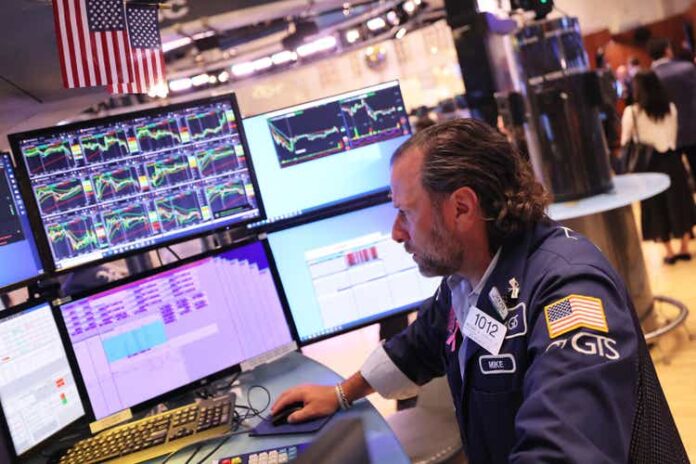
Photo by Michael M. Santiago
Thursday was a banner day for Wall Street. The major averages surged, buoyed by a surge in semiconductor stocks and a powerhouse performance by tech titan Apple, which offset a dip in managed care entities. Moreover, Treasury yields trended upwards as a bond sell-off persisted.
Nasdaq and S&P 500 Hit High Notes
The tech-heavy Nasdaq Composite (COMP.IND) _leapt_ 1.35% to close at 15,055.65 points, while the benchmark S&P 500 (SP500) gained 0.88% to settle at 4,780.92 points. Chip names led the charge after Taiwan Semiconductor Manufacturing (TSM)’s robust 2024 projections. Additionally, industrial supplier Fastenal (FAST) delivered results that outperformed market estimates.
The Dow (DJI) closed 0.54% higher at 37,468.61 after veering back from a 0.3% decline, driven by Apple (AAPL) climbing over 3%. However, a sharp downturn in profit guidance from Humana (HUM) triggered widespread losses among health insurers, with UnitedHealth (UNH), Molina Healthcare (MOH), Elevance Health (ELV), and CVS Health (CVS) among the notable casualties.
Sector Performance and Fixed-Income Markets
Of the 11 S&P sectors, seven ended in the green, with Technology and Communication Services leading the pack, while Utilities and Real Estate trailed. Meanwhile, in fixed-income markets, Treasury yields continued to climb as the recent bond sell-off, catalyzed by a recalibration of Federal Reserve rate cut expectations, showed minimal signs of slowing.
The longer-end U.S. 30-year yield (US30Y) surged by 6 basis points to 4.37%, whereas the 10-year yield (US10Y) jumped by 4 basis points to 4.14%. The shorter-end and more interest rate-sensitive 2-year yield (US2Y) inched up to 4.35%. The movement in Treasury yields can be viewed across the curve at the Seeking Alpha bond page.
Economic Data and Market Sentiment
Thursday’s economic calendar was fairly busy, with housing starts falling and building permits surpassing December 2023 estimates. Unexpectedly, the number of initial jobless claims filed by Americans dropped, and the Philadelphia Fed’s manufacturing index showed a slight improvement in January. While the S&P 500 has struggled in 2024 with a 0.64% decline, the markets have been grappling with uncertainty.
Leo Nelissen, a part of the investing group iREIT on Alpha, remarked, “If there’s one thing I have learned in recent weeks, it’s that we may be in the most tricky phase of the economic cycle. On one hand, we have investors expecting the Fed to cut rates six times this year (which has been priced in) before continuing its path to normalization in 2025. On the other hand, we have people who expect that sticky inflation will cause the Fed to remain more hawkish than the market may expect, potentially leading to market adjustments over the next 2-3 months. I am in the second group of people.”
“Even worse is that economic data continues to come in mixed. While core inflation remains too high, close to 4%, leading manufacturing indicators like the Philly Fed and New York Fed surveys indicate significant weakness ahead. Meanwhile, jobless claims continue to drop,” Nelissen added.
Active Movers
Banking and financial services firms Discover Financial Service (DFS) and KeyCorp (KEY) declined by 11% and 5%, respectively, after the former’s quarterly provision for credit losses ballooned and the latter issued underwhelming net interest income guidance. Additionally, Birkenstock (BIRK) stumbled by 8% following the footwear maker’s disappointing first quarterly results since going public.

